Prehistoric Fantasy from the Days Before the Earth had a Moon: Jane Gaskell’s Atlan Saga, Part I
The Quest for the Complete Series
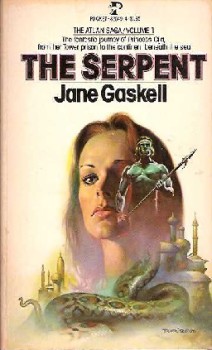
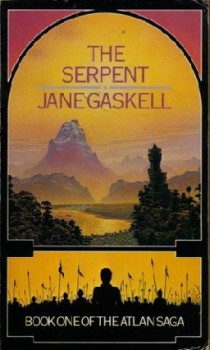
In my quest to revive interest in forgotten or overlooked fantasies, it would be remiss not to discuss Jane Gaskell, specifically her Atlan Saga. The fact that my past few posts about H Warner Munn also happen to reference Atlantis is purely coincidental, and I am by no means an expert on all things Atlantean.
I came upon Jane Gaskell’s Atlan Saga in the late 1980s. As a high school lad in South Africa with limited funds, the public and school libraries — as well as friends — were my main sources of fantasy material. While many folks I know seem to have been reading Heinlein and Tolkein by the time they were 10, I only started reading for pleasure as a pre-teen. Until then I actively despised it. That is not to say I didn’t enjoy a good story, just I was too lazy to read it myself. My mother desperately tried to encourage me, but I recall thinking Enid Blyton (Secret Seven etc.) was really nyaff, and the Hardy Boys were too mainstream.
Fortunately I discovered Biggles by Captain WE Johns and my mind, at last, opened to the joys of reading. After moving through CS Forester’s Hornblower books and Alexander Kent’s Richard Bolitho series (both period sea adventure), I found myself looking for something different. I found it through friends who introduced me to Anne McCaffery’s Dragonflight and David Eddings’ Belgeriad books.
One of the factors hindering me at the time was that good material was relatively thin on the ground. I also had a juvenile dislike of second hand books, preferring to buy them new. Sure, the shops had a reasonable amount on their shelves, and there were a (very) few specialist shops with a plethora of gear to choose from, but most of it was out of my price range, or my sphere of travel. Fortunately the major chain store of the day, CNA (like a Borders I imagine) used to have an annual book sale just after Christmas where they moved loads of old warehouse stock. During one of these sales I encountered two slim volumes which, due to their awesome cover art, just had to be fantasy par excellence: The Dragon and The City, both by Jane Gaskell.
[Click on any of the images for bigger versions.]
I had never heard of her, but then again in my youth I thought David Eddings was the all-time king of fantasy, and had never heard of Glen Cook, Clark Ashton Smith, Robert E Howard, Lord Dunsany et cetera. I was disappointed to see they were books two and four of a series, but I had experienced such book sales before, and with youthful optimism that another CNA would definitely have the other volumes, I forked out the princely sum of ZAR2.50 each (it was the 80s) and trotted home. At last, my fantasy book collection has begun!
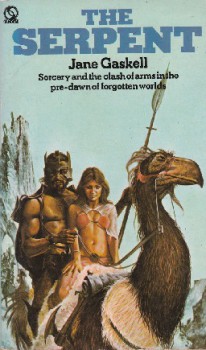
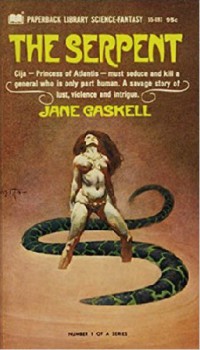
Annoyingly, the other CNA did not have books one and three. I trolled through several outlets to no avail. The sale ended and I gave up, leaving the two books gathering dust on my shelf.
Fast forward a year, to when I had the opportunity to visit my older sister in another city. I discovered a local (now long gone) set of bookshops called Paperbacks, and joy of joys, they too had a sale table where I came across books three and five, Atlan and Some Summer Land. While I was happy to see the series had a fifth book, I was once again frustrated in my quest for the first volume.
I eventually gave up my quest to find book one, The Serpent, in any discounted sale and approached the then holy grail of fantasy, science fiction book and record shops, Universitas (also long gone), to order it. They did so, but never notified me when it arrived. I assumed they hadn’t bothered with the order, but then, on one of my friend Graham and my periodic after-school bus trips into the city, while scanning the shelves at Universitas, I came across The Serpent. I assumed they must have ordered it, failed to get hold of me, and just added it to their shelf stock.
All the books I finally had in hand were reprints, published under the Orbit Books Futura Science Fiction (UK) imprint in 1985. The cover art and design is classically UK 1980s fantasy style, but the artist is not credited.
The Serpent was originally published as a single volume in 1963. Since then it has seen been republished a number of times, more often than not split into two volumes: The Serpent and The Dragon. As the initial volume bears the same name, and was not apparently intended to be split into two separate books, it becomes incumbent on the reader to know what volume they are reading, at the risk of either missing out on The Dragon or having a superfluous copy of same. For the purposes of this article I am covering The Serpent as a separate book, and will write about The Dragon in a future supplement.
What’s in the Book?
The Serpent tells the story of a girl called Cija. Written in first person, it details Cija’s adventures – or more accurately misadventures – in her diary. The setting is loosely based on prehistoric South America, but for the most part is pure fantasy. Looking back at when I first read them, I muddled through this series alternating between being impressed and coming close to putting it down in boredom. To be fair to this summary, I had to give it a re-read as it has been decades since I read it.
Firstly — well done Jane Gaskell — in terms of background research. The book features giant predatory birds used as mounts. As we know horses were not endemic to the Americas, and it has been proven that there were indeed predatory birds in South America. Gaskell did quite a lot of background research and even included a bibliography, which one has to admit is not a common sight in a fantasy book. The bird mounts stuck with me, even though I had long forgotten most of the story. One has to wonder if, considering the publication date, that may have been an influence on Greg Stafford’s Glorantha, which features giant predatory domesticated Demi Birds.
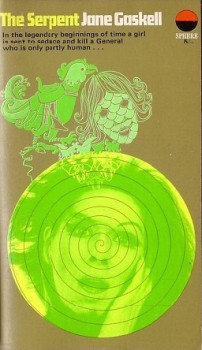
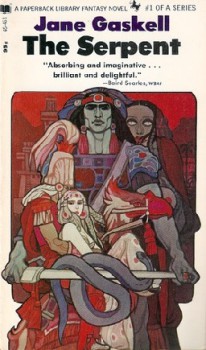
The edition of The Serpent I read comes to 316 pages (317 including the bibliography). It is split into five long chapters. Part One, the shortest, gives us background on seventeen year old Cija, who has been raised in relative solitude in an ancient tower, with only her long time nurses as companions. We’re told she is a princess, a goddess, whose mother, the dictatress of what appears to be a small kingdom or perhaps city state, has closeted her daughter away in the tower since birth. She is naive and rebellious, and takes small pleasures in hiding from her nurses so that she can look out of a secret window at the world beyond.
I found myself loving Ms Gaskell’s prose. In as few as ten pages in I overcame my apprehension of re-reading the series, and was drawn into her wonderfully descriptive writing style. While I’m not a huge fan of first person, here it works, as the world unfolds through Cija’s eyes, seen through the mechanism of her diary.
Once the setting is established the story starts to unfold rapidly. We learn Cija was secreted away due to a prophecy that foretold she would bring disaster to the land. Overnight we learn the so-called disaster has befallen, as an invading army has arrived in transit to a war in another land. Cija’s homeland, we discover, has previously been ravished by the father of the general who leads the army, and it has taken a generation of hard work to restore it to a semblance of prosperity. Now the general, Zerd, and his army have returned, demanding hostages to ensure that the Dictatress’ small army does not rise up and attack them from the rear as they march west towards their new conquest.
Cija’s is freed from her tower to become one of the hostages. Her mother charges her with becoming close to general Zerd and slitting his throat in an intimate moment. But Cija is woefully unprepared, having been cosseted to such an extent that it comes as a shock to her that men are not extinct. She is shy and lacks confidence, which makes her all the more believable. The silly girl I perceived as a youngster is still there, but now I can enjoy her character with an understanding that maturity brings.
While The Serpent delves into various earth myths and history, to deliver a fantastic, yet believable land, the high point of the story has to be Ms Gaskell’s strong characterizations and descriptive prose. We see Cija slowly grow from an isolated, somewhat spoiled child as the book progresses. Other characters initially only hinted at also grow and become three dimensional, with their own set of motivations witnessed through Cija’s eyes.
The book unfolds as the army progresses on its long march to an apparent preemptive strike against the Southern Empire. Cija gradually learns to interact with her fellow hostages, as well as certain army officers, as she seeks to get closer to general Zerd, whom we discover is a hybrid of reptile and man. She attracts the romantic overtures of a fellow hostage, Smahil, while her straightforward mannerisms soon alienate her from the other hostages.
Jane Gaskell
Cija’s luck turns sour once they are in the outlying reaches of the Southern Empire. We discover that the Northern Army plans to initiate an alliance with their Southern Counterparts, and together sail to war against a near mythical civilization known as Atlan. While the guests of a towns governor, Cija finds herself betrayed at various levels, eventually left behind by the army as the town governor’s property. Ms Gaskell does not pull punches and quite matter-of-factly tells of the abuses that follow. Fortunately Cija finally escapes and makes her way south, making friends and enemies along the way and finally finding herself in the Southern Capital, disguised as a young boy and in the employ of the Northern Army as a cook.
She is finally recognized by one of her fellow hostages, Smahil, who is now an officer in the army and who still apparently loves her, though she’s been rejecting his advances since Chapter Two. When tensions between the allied forces come to a head and a rolling street battle ensues, Smahil and Cija slip away into the hills, which is where the book abruptly ends – or doesn’t, depending on which version of The Serpent you’re reading.
I will hold back on my final rating until I review The Dragon, as the abrupt end to the edition I read definitely left me with the feeling that the book had been cut off — which of course it had. One small comment I can share is that when I was describing the book to my wife, she said it sounded like a girls book, which I suppose it is. It may also reveal why as a kid it did not resonate with me, but now as an adult, with (hopefully) more insight, I find it appealing.
The Serpent has been republished a number of times. I was able to trace eleven different covers in the English language. It is hard to pick a favorite but one cannot ignore the fact that big names such as Frank Frazetta (Paperback Library) and Boris Vallejo (Pocket Books) have provided cover art. Personally, while the Orbit / Future version is still a top runner, I like the Tandem version by Dave Pether the best.
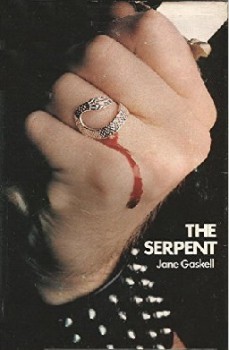 White Lion – Artist unknown White Lion – Artist unknown |
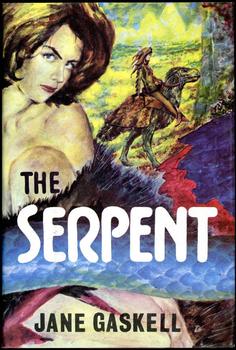 Hodder & Stoughton – Denvil Hodder & Stoughton – Denvil |
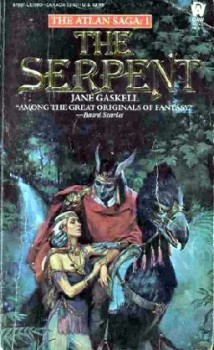 DAW – James Gurney DAW – James Gurney |
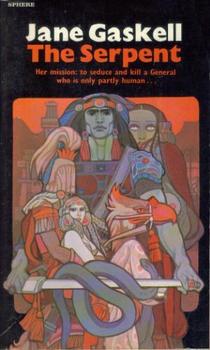 Sphere – Bill Bolten Sphere – Bill Bolten |
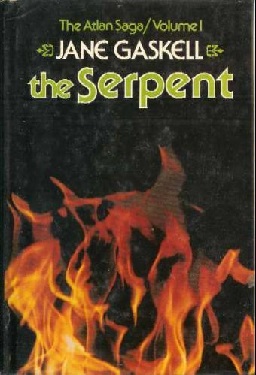 St Martin’s Press – Laurel Marx St Martin’s Press – Laurel Marx |
Tony Den’s most recent article for Black Gate was Atlantis, Vikings, and the Hordes of Kublai Khan: Merlin’s Ring by H. Warner Munn. His personal website www.runequest.za.org is busy undergoing a slow migration to Word Press.
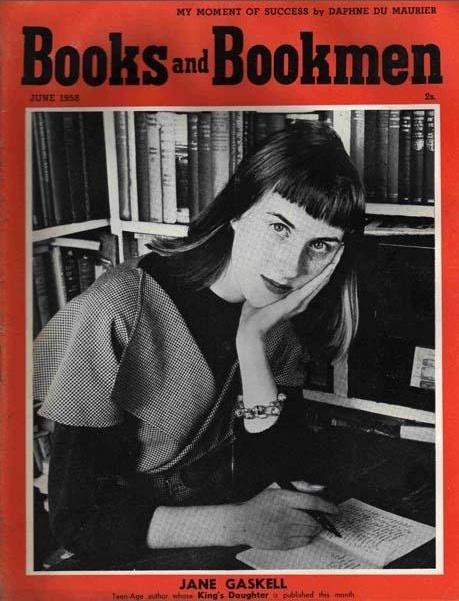
I remember first encountering these books at the public library back when I was in high school, I think — the St. Martin’s Press editions. I don’t think I got through the entire series at that point, but I did like what I read.
I’ve since read the entire series at least once, and it’s on my nigh-infinite list of things to revisit — I wish they’d put out eBook editions. Ah, well.
I do like the Bolten covers — I think that’s what I have on my (second-hand) paperbacks of the first three (four). The White Lion and Hodder & Stoughton, on the other hand …
Thanks Joe. Yes strange a series reprinted so many times hasn’t come out in eBook yet. I also like the Bolten cover it was a close call. Just wish I could find out who painted the Orbit Futura cover. If you look at the corgi UK paperbacks of 1980’s, covers for David Eddings, Lyndon Hardy et al there is a relatively common theme, or at least atmosphere.
Amazing. I read this series back in the late 90s.
This is new to me, I guess I just didn’t stumble across the books, somehow, though with so many reprints you’d think I would have. I’m with you on the covers, I really like the Orbit/Future cover, such a classic style, but would probably have purchased the Tandem/Pether. I note that the Sphere/Bolten with the green spiral is pretty awful.
Agreed RK. That green cover I would have passed over without a second glance.